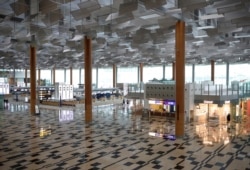Students in Singapore returned to school on Monday, bucking a global trend of coronavirus-driven closures and signaling that the quick crisis response may be letting the nation and the economy return to normal earlier than others.
Grade schools began their new term but with extra precautions, including 14 days of confinement for those who return from overseas and health checks twice a day for kindergartners, said the Ministry of Education.
The ministry also asked companies to help make arrangements for their staff if they have to remain in confinement with their school-age children. The request highlights the economic impact COVID-19 has had on parents in many nations who must stay home with children while schools are closed.
While other nations are still discussing how serious the virus may be, Singapore has been responding to it since January, when its first case was reported. The island state’s response included early and mass testing, restricted movement, and financial support as economic activity slowed down.
“We will continue to monitor the situation closely and work with schools, preschools, parents and the community to ensure that our schools and preschools remain a safe and secure environment,” the education ministry said. The ministry added that for parents who must stay home, “Employers are encouraged to provide flexible work arrangements for their employees to accommodate such exceptional circumstances.”
Singapore has been able to mostly contain the virus so far, but the economic impact has already appeared. Travel, consumption, and trade have decreased. Singapore is also highly exposed to the oil market as a trading hub, so a price war between Russia and Saudi Arabia is adding to the commercial problems set off by the pandemic.
Moody's Investors Service forecast the nation would see zero growth in gross domestic product in the first half of the year.
“Singapore [is] particularly susceptible to swings in the global economy through its external trade orientation and large exposure to China," Eugene Tarzimanov, a vice president and senior credit officer at Moody’s, said.
Economic activity is expected to pick up again now that children and teachers can go back to the classroom. The Ministry of Education said children who have to stay in temporary confinement will be provided with online teaching.
It also said that officials spent the month of March sanitizing the schools, from jet washing the cafeterias to shampooing the carpets. While students are on campus, there will be assigned seats. They will have no extracurricular activities. Wipe-down routines for the classrooms and cafeterias are also being implemented, according to the ministry.
These are part of measures more broadly taken across the island nation to contain the novel coronavirus outbreak; however, some of the factors that contributed to containment in Singapore may not necessarily be applicable to other nations.
Observers say those factors range from the geography and population of fewer than 6 million people, to the strong central government and higher level of surveillance. For instance, the state has created a smartphone app that notes users’ location and proximity to other users, a tool that could help with contact tracing for people who become infected. The news set off a debate about the need to balance public health and safety with individuals’ right to privacy.









